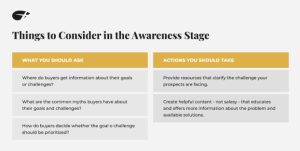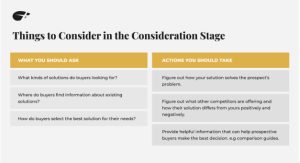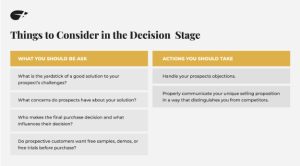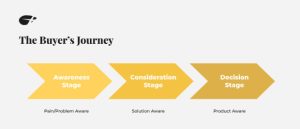Contributed by SeedX
The buyer’s journey can be broken down into 3 main steps:
- Awareness stage – Where the customer realizes they have a problem or need.
- Consideration stage – Where the customer explores various solutions to address their need.
- Decision stage: The customer evaluates their options and makes a purchase decision.
Understanding these steps is crucial for effectively guiding customers toward a purchase.
1. Awareness stage
In the awareness stage of the buyer’s journey, prospects recognize they have a problem that needs a solution. At this point, they are open to all options and typically begin their journey by researching to better understand their situation. This often involves using search engines like Google or engaging with content on social media platforms.
As a business, you need to consider how and where your prospects are educating themselves about their problems. You should then start thinking about:
- How to align your offerings with the initial concerns of your prospects.
- How to communicate the urgency of your solution.
- Whether there is a proactive way to engage your prospects early, such as through prospecting emails.
Key Metric: 71% of B2B researchers start with a generic search, rather than looking for a particular brand.
Understanding and engaging with prospects in the awareness stage sets the stage for moving potential customers along to the next steps of their buying journey. One of the best ways to engage prospects is by leveraging content that frames the prospect’s problem.
You can engage prospects effectively by using:
- Blogs to provide in-depth educational material.
- Search engine marketing to ensure your content is discoverable.
- Social media marketing to engage prospects on the platforms where they typically begin their information search.

2. Consideration Stage
In the consideration stage, prospects actively search for solutions to their problem. They have a clear understanding of their issue and are researching how to address it with more intent.
As a business, you should ask the following questions to grasp the needs of prospects at this stage:
- How do prospects determine what information is valuable or credible?
- What keywords or phrases do they use to search for solutions after defining their problem?
- What features or aspects of a solution do prospects find most valuable?
- Are prospects utilizing a lead management system to aid their decision-making process?
During this phase, it’s crucial to highlight how your solution stands out from the competition. It’s also very important to understand how prospects perceive your solution vs. other solutions available in the marketplace.
This stage often involves extended engagement, nurturing leads, building relationships, and establishing trust between the audience and the brand.
Effective channels for engaging prospects in the consideration stage include:
- Website or blog content
- Search engine marketing
- Email marketing
- Social media.
These platforms offer opportunities to provide targeted content and interact with prospects as they explore their options.

3. Decision Stage
In the decision stage, prospects are confident they’ve found a solution to their problem and are ready to choose the product or service that will best address it at the right price. While they’re nearing the finish line, it’s essential for your sales personnel to exceed expectations in every interaction to prevent them from backing out or turning to a competitor at the last moment.
Key metric: 65% of buyers spend more than 16 minutes comparing before making a decision-stage purchase
To effectively navigate the decision stage, you should consider the following questions to understand the needs of your prospects:
To effectively navigate the decision stage, you should consider the following questions to understand the needs of your prospects:
How many individuals are involved in the purchasing decision? Is it a single consumer or multiple stakeholders?
Are there any last-minute concerns or considerations prospects typically have before making a purchase?
Will prospects require any onboarding or product training post-purchase?
To ensure success, it’s important to create a unique selling proposition that distinguishes you from competitors. Make sure your bottom-of-the-funnel content marketing highlights what makes you different and addresses common concerns. Additionally, equip your sales team with prepared responses to objections to enhance their effectiveness in interactions.
For effective delivery of content in the decision stage, you may utilize:
- Website content
- Email marketing
- Live chat or chatbots for immediate service and support
Successfully navigating the decision stage hinges on highlighting your unique value proposition, addressing concerns proactively, and empowering your sales team with the right tools and strategies.

While making a purchase might be the end of the buyer’s journey, it is the beginning of the customer journey. The buyer’s journey focuses on acquiring customers, while the customer journey focuses on retaining customers for the long term.
Customer retention is more important than acquisition. Here’s why:
- Acquiring a new customer can cost up to five times more than retaining an existing one.
- A modest 5% increase in customer retention rates can translate to profit boosts ranging from 25% to a staggering 95%.
To realize these benefits, you need to shift your attention to your existing customers and focus on:
- Providing exceptional post-purchase experiences and personalized communication.
- Engaging customers through targeted emails, exclusive offers, and loyalty programs.
- Facilitating opportunities for satisfied customers to share their positive experiences through referral programs, incentivized sharing, and user-generated content campaigns.
By investing in initiatives that foster customer loyalty and transform them into enthusiastic advocates, you can lay the groundwork for your business’ enduring success.
Difference Between B2B and B2C Buyer’s Journey
The journey from consideration to purchase can vary significantly depending on factors such as industry, business model, product, pricing, and audience. For instance, B2C customers swiftly move through the buyer’s journey. On the other hand, B2B customers often require more nurturing, engagement, and relationship-building before making a purchase decision.
Business-to-consumer (B2C) buyer’s journey
In the realm of business-to-consumer (B2C) transactions, customers typically buy products or services for themselves or those they know well. These purchases are often driven by emotion, prompting B2C marketers to appeal to consumers’ desires and interests. Sales cycles in B2C can range from mere moments to several months, depending on how motivated the consumer is.
Business-to-business (B2B) buyer’s journey
On the other hand, the business-to-business (B2B) buyer’s journey involves organizations procuring products or services for their operations. The primary driver behind these purchases is the return on investment (ROI). B2B marketers must emphasize how their offerings can enhance efficiency, profitability, or sales revenue.
Due to the involvement of multiple decision-makers, B2B sales cycles tend to be longer and require careful consideration before a purchase is made.
Conclusion
Understanding the buyer’s journey and delivering tailored content at each stage is crucial for modern businesses. By aligning marketing efforts with the needs and behaviors of prospects, companies can effectively engage their audience, nurture leads, and drive conversions.
If you’re interested in mapping out your buyer’s journey and creating strategic marketing content, get in touch with SeedX — a full-service digital marketing agency that specializes in custom marketing solutions for enterprise and B2B businesses















